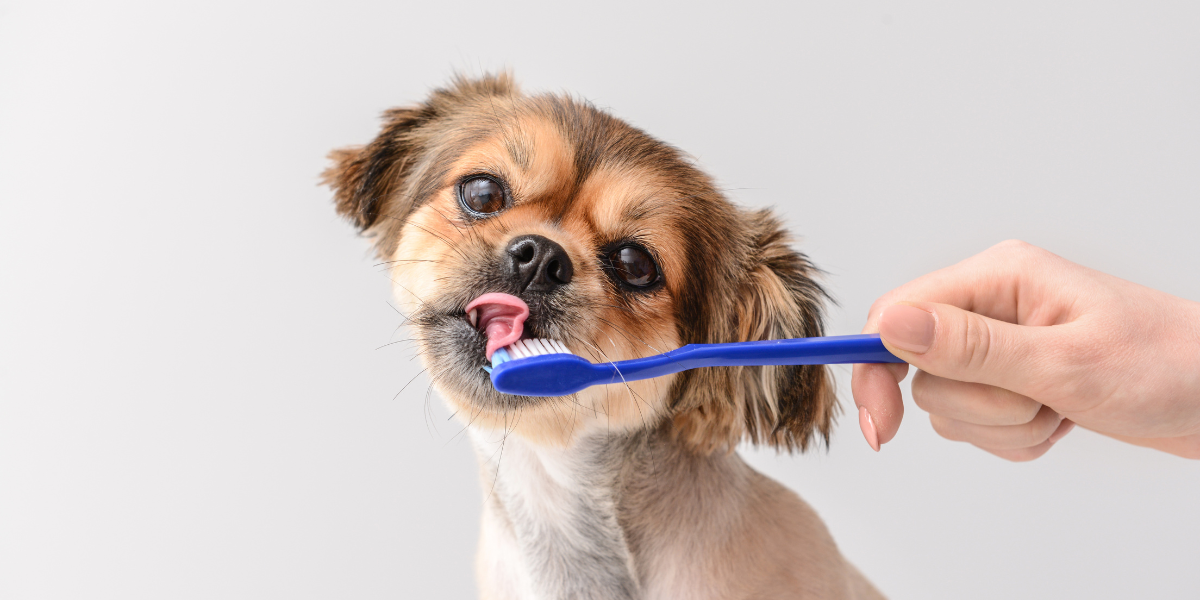Brushing your dog’s teeth is not that hard but also … it’s not that fun. However, brushing is an important aspect of your dog’s dental care, so it is necessary. And, it’s essential to do it correctly because if you brush badly, you can actually cause more dental issues than you solve. Also, it is a bit of a challenge to build up a solid tooth-brushing routine with your dog. This article addresses the top ten problems that arise when building a tooth-brushing program and tips on how to prevent them.
Problem 1 – Inadequate Introduction to Toothbrushing
- Issue: Once you’ve resolved to start a brushing program, you easily come across as too forceful and fast to suit your dog. Rushing the introduction to toothbrushing can lead to stress or fear in your dog.
- Prevention: Gradually introduce the toothbrush and toothpaste to your dog. Start by letting them sniff and lick the toothpaste. Use positive reinforcement, treats, and praise to make the experience positive.

Problem 2 -Using the Wrong Tools
- Issue: It’s so tempting! You have five old and frayed toothbrushes lying around. Why not use them on the dog? Actually, using a human toothbrush or toothpaste can be harmful to dogs.
- Prevention: Use a dog-specific toothbrush and toothpaste. Dog toothbrushes have softer bristles, and dog toothpaste is formulated to be safe for dogs, as they may swallow some during brushing. Also using an enzymatic toothpaste gives your pup an extra post-brushing boost from those enzymes as they continue to break down plaque once your brushing session is over. Here are some other benefits of using the right tools:
- Mechanical Removal of Plaque:
- Effective in preventing the buildup of plaque, which can lead to tartar formation and dental issues.
- Massaging the Gums:
- Brushing also massages the gums, promoting good gum health. Healthy gums are crucial for overall oral well-being and can help prevent conditions like gingivitis and periodontal disease.
- Even Distribution of Enzymes:
- The toothbrush ensures an even distribution of the enzyme toothpaste throughout the mouth. This helps in targeting all teeth and surfaces, ensuring a more thorough cleaning.
- Better Control and Precision:
- Using a toothbrush gives you better control and precision in reaching all areas of your dog’s mouth. It allows you to access the back teeth, which are often more prone to plaque buildup.
- Establishing a Routine:
- Brushing with a toothbrush helps establish a routine, making the process more effective and easier over time. It also provides a positive bonding experience between you and your dog.
- Mechanical Removal of Plaque:
If your dog is resistant to toothbrushing, you can start by introducing the toothpaste and brushing gradually. Begin by letting your dog lick the toothpaste to get used to the taste. Then, introduce the toothbrush by allowing your dog to sniff and lick it. Finally, gently brush a few teeth at a time, gradually increasing the duration as your dog becomes more comfortable.
If your dog absolutely refuses to tolerate a toothbrush, there are alternative options, such as dental wipes or dental chews. While these can provide some benefit, they may not be as effective as regular brushing with a toothbrush.

Problem 3 – Brushing Too Aggressively
- Issue: Brushing too vigorously can cause discomfort or damage to your dog’s gums and teeth.
- Prevention: Be gentle and use circular or back-and-forth motions. Focus on the outer surfaces of the teeth and gums. If your dog resists, take breaks and gradually increase the duration of brushing.
Problem 4 – Neglecting the Back Teeth
- Issue: Neglecting the back teeth can lead to plaque and tartar buildup in areas that are harder to reach.
- Prevention: Pay attention to all teeth, including the molars and premolars. Lift your dog’s lips to access the back teeth and ensure a thorough cleaning.
Problem 5 – Infrequent Brushing
- Issue: Infrequent brushing may not effectively prevent plaque and tartar buildup. For some breeds (looking at you, Italian greyhounds!), daily brushing is necessary. For others, a few times a week might suffice. Looking inside the mouth for bad breath, yellow or brown discoloration, inflamed gums, and visible tartar buildup will tell you a lot about the effectiveness of your brushing program.
- Prevention: Establish a regular brushing routine, aiming for at least a few times a week. Consistency is key to maintaining good oral health.
Problem 6 – Skipping Professional Dental Care
- Issue: Relying solely on at-home brushing and neglecting professional dental cleanings can lead to undetected dental issues.
- Prevention: Schedule regular dental check-ups with your veterinarian. Professional cleanings are essential for removing stubborn plaque and tartar and addressing any underlying dental problems.
Problem 7 – Ignoring Signs of Discomfort
- Issue: Ignoring signs of discomfort or distress during toothbrushing can create a negative association for your dog.
- Prevention: Pay attention to your dog’s body language. If they seem uncomfortable or resist, stop and try again later. Positive reinforcement and patience can help create a more positive experience.
Problem 8 – Neglecting Other Aspects of Dental Care
- Issue: Relying solely on toothbrushing and neglecting other dental care aspects may not provide comprehensive oral health.
- Prevention: In addition to brushing, provide dental chews, toys, and consider incorporating dental-friendly diets. These can complement the benefits of toothbrushing.

Problem 9 – Ignoring Dental Issues
- Issue: Ignoring signs of dental issues, such as bad breath or swollen gums, can lead to more significant problems.
- Prevention: Regularly check your dog’s mouth for signs of dental problems. If you notice any issues, consult with your veterinarian promptly.
Problem 10 – Lack of Patience
- Issue: Impatience is the number one killer of home dental hygiene programs. An impatient approach will result in a rushed and ineffective brushing session and probably a generally bad experience for both you and the pet.
- Prevention: Take your time, be patient, and gradually build a positive association with toothbrushing. Short, positive sessions are more effective than long, stressful ones.
Conclusion
If you encounter challenges while brushing your dog’s teeth, consider seeking guidance from your veterinarian or a professional dog trainer. They can provide tips, recommend alternative dental care methods, and ensure that your dog’s oral health needs are met effectively.
Remember that each dog is unique, and their dental care needs may vary. Regular attention to your dog’s teeth, combined with professional veterinary care, will contribute to a lifetime of good oral health. If you have specific concerns or questions about your dog’s dental care, consult with your veterinarian for personalized advice.













